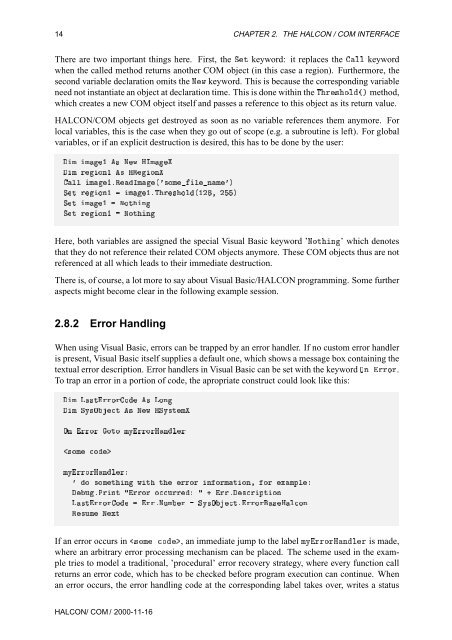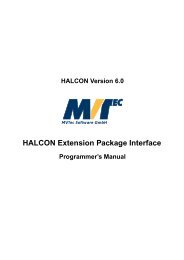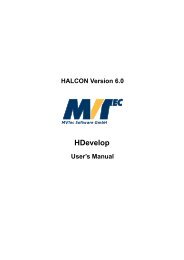HALCON/COM User's Manual
HALCON/COM User's Manual
HALCON/COM User's Manual
You also want an ePaper? Increase the reach of your titles
YUMPU automatically turns print PDFs into web optimized ePapers that Google loves.
14 CHAPTER 2. THE <strong>HALCON</strong> / <strong>COM</strong> INTERFACE<br />
There are two important things here. First, the ËØ keyword: it replaces the ÐÐ keyword<br />
when the called method returns another <strong>COM</strong> object (in this case a region). Furthermore, the<br />
second variable declaration omits the ÆÛ keyword. This is because the corresponding variable<br />
need not instantiate an object at declaration time. This is done within the ÌÖ×Óдµ method,<br />
which creates a new <strong>COM</strong> object itself and passes a reference to this object as its return value.<br />
<strong>HALCON</strong>/<strong>COM</strong> objects get destroyed as soon as no variable references them anymore. For<br />
local variables, this is the case when they go out of scope (e.g. a subroutine is left). For global<br />
variables, or if an explicit destruction is desired, this has to be done by the user:<br />
Ñ Ñ½ × ÆÛ ÀÁÑ<br />
Ñ ÖÓÒ½ × ÀÊÓÒ<br />
ÐРѽºÊÁÑ´³×ÓÑÐÒѳµ<br />
ËØ ÖÓÒ½ ѽºÌÖ×Óд½¾¸ ¾µ<br />
ËØ Ñ½ ÆÓØÒ<br />
ËØ ÖÓÒ½ ÆÓØÒ<br />
Here, both variables are assigned the special Visual Basic keyword ’ÆÓØÒ’ which denotes<br />
that they do not reference their related <strong>COM</strong> objects anymore. These <strong>COM</strong> objects thus are not<br />
referenced at all which leads to their immediate destruction.<br />
There is, of course, a lot more to say about Visual Basic/<strong>HALCON</strong> programming. Some further<br />
aspects might become clear in the following example session.<br />
2.8.2 Error Handling<br />
When using Visual Basic, errors can be trapped by an error handler. If no custom error handler<br />
is present, Visual Basic itself supplies a default one, which shows a message box containing the<br />
textual error description. Error handlers in Visual Basic can be set with the keyword ÇÒ ÖÖÓÖ.<br />
To trap an error in a portion of code, the apropriate construct could look like this:<br />
Ñ Ä×ØÖÖÓÖÓ × ÄÓÒ<br />
Ñ ËÝ×ÇØ × ÆÛ ÀËÝ×ØÑ<br />
ÇÒ ÖÖÓÖ ÓØÓ ÑÝÖÖÓÖÀÒÐÖ<br />
×ÓÑ Ó<br />
ÑÝÖÖÓÖÀÒÐÖ<br />
³ Ó ×ÓÑØÒ ÛØ Ø ÖÖÓÖ ÒÓÖÑØÓÒ¸ ÓÖ ÜÑÔÐ<br />
ÙºÈÖÒØ ÖÖÓÖ ÓÙÖÖ · ÖÖº×ÖÔØÓÒ<br />
Ä×ØÖÖÓÖÓ ÖÖºÆÙÑÖ ¹ ËÝ×ÇغÖÖÓÖ×ÀÐÓÒ<br />
Ê×ÙÑ ÆÜØ<br />
If an error occurs in ×ÓÑ Ó, an immediate jump to the label ÑÝÖÖÓÖÀÒÐÖ is made,<br />
where an arbitrary error processing mechanism can be placed. The scheme used in the example<br />
tries to model a traditional, ’procedural’ error recovery strategy, where every function call<br />
returns an error code, which has to be checked before program execution can continue. When<br />
an error occurs, the error handling code at the corresponding label takes over, writes a status<br />
<strong>HALCON</strong>/ <strong>COM</strong> / 2000-11-16
















